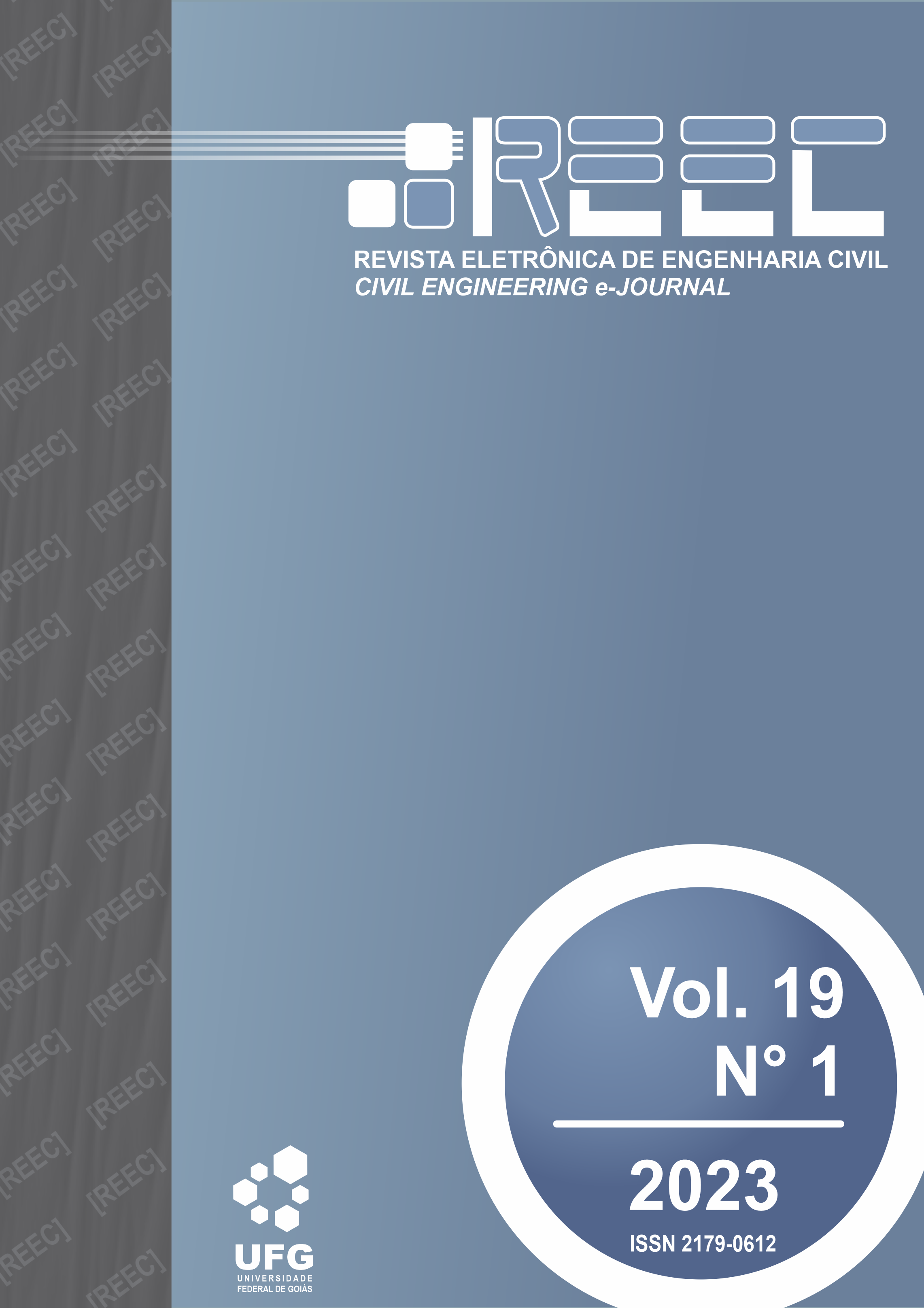Heat transfer in materials for covering
DOI:
https://doi.org/10.5216/reec.v19i1.73281Keywords:
Thermal performance, Heat transfer, Isolation, Thermal comfort, Energy efficiencyAbstract
ABSTRACT: Climate changes have influenced the microclimate of urban centers and the characteristics of buildings. The thermal performance of the surroundings can interfere with the energy efficiency and sustainability of the building due to the use of air conditioning. The research aims to evaluate the differences between external and internal temperatures in prototypes with different roof materials. The manuscript includes applied research using different materials, with and without thermal insulation, in roofs such as fiber cement tiles, ceramic tile, and metallic tile applied in prototypes built with plasticized wood panels. In the experiment, the temperatures of the external and internal environments of the prototypes were evaluated. Also, the temperatures on the external and internal faces of the roofs were verified using an infrared thermometer and an ambient thermometer. The data obtained in the temperature assessments were collected over a period of 5 days, at three different times (10, 12, and 16 hours), organized, and analyzed in a spreadsheet. The results showed that there was a significant variation between the roofs with and without thermal insulation. As for the type of cover, the study concludes that the metal tile with insulation presented the best insulation results, reducing the heat transfer from the external environment to the internal environment of the prototypes.
Downloads
References
ABNT, Associação Brasileira de Normas técnicas. NBR 15220 - Desempenho térmico de edificações Parte 1: Definições, símbolos e unidades. . Rio de Janeiro: [s.n.]. Disponível em: . Acesso em: 1 fev 2020. , 2003
ABNT, ASSOCIAÇÃO BRASILEIRA DE NORMAS TÉCNICAS. NBR 15575-2021 - Desempenho térmico. . Brasil: [s.n.]. Disponível em: <https://labeee.ufsc.br/NBR15575-2020>. Acesso em: 22 abr 2022. , 2021
ABREU, Paulo G. De et al. Análise termográfica da temperatura superficial de telhas. Revista Brasileira de Engenharia Agrícola e Ambiental, v. 15, n. 11, p. 1193–1198, Nov 2011. Disponível em: <http://www.scielo.br/scielo.php?script=sci_arttext&pid=S1415-43662011001100013&lng=pt&tlng=pt>. Acesso em: 23 fev 2021.
ANDRIC, Ivan e KAMAL, Athar e AL-GHAMDI, Sami G. Efficiency of green roofs and green walls as climate change mitigation measures in extremely hot and dry climate: Case study of Qatar. Energy Reports, v. 6, p. 2476–2489, Nov 2020. Disponível em: <https://linkinghub.elsevier.com/retrieve/pii/S235248472031310X>.
BARTHOLOMEI, Carolina. Influência da vegetação no conforto térmico urbano e no ambiente construído. 2003. 205 f. f. Universidade Estadual de Campinas, Campinas, 2003.
BUENO, Bruno et al. Calculation of Air Temperatures above the Urban Canopy Layer from Measurements at a Rural Operational Weather Station. Journal of Applied Meteorology and Climatology, v. 52, n. 2, p. 472–483, 1 Fev 2013. Disponível em: <http://journals.ametsoc.org/doi/10.1175/JAMC-D-12-083.1>.
CAIXA, CAIXA Econômica Federal. Selo Casa Azul + Caixa. . Brasil: [s.n.]. Disponível em: <https://www.caixa.gov.br/Downloads/selo_casa_azul/guia-selo-casa-azul-caixa.pdf>. Acesso em: 2 jun 2022. , 2021
CÂNDIDO, Carolina Dieguez e DORNELLES, Kelen Almeida e LUKIANTCHUKI, Marieli Azoia. Impacto da absortância no conforto térmico em três zonas bioclimáticas. PARC Pesquisa em Arquitetura e Construção, v. 14, p. e023003, 2023.
CASTRO, L. C. et al. Evaluation of the thermal performance of different cold materials for urban paving. Ceramica, v. 63, n. 366, p. 203–209, Abr 2017. Disponível em: <http://www.scielo.br/scielo.php?script=sci_arttext&pid=S0366-69132017000200203&lng=en&tlng=en>.
CAVALCANTI, André Marques et al. Análise da qualidade do ar interno sob a abordagem da manutenção preditiva e da inovação. Exacta, v. 13, n. 1, p. 45–54, 25 Ago 2015. Disponível em: <http://periodicos.uninove.br/index.php?journal=exacta&page=article&op=view&path[]=5259>.
CHRISCHON, Dieivase et al. Análise do desempenho acústico de telhas sanduíche para aplicação no fechamento lateral de edificações. 2018, Porto Alegre - RS: Universidade Federal de Santa Maria, 2018. Disponível em: <https://proceedings.science/proceedings/113/_papers/87115>.
DIAS, Alexandra da Silva. Avaliação do desempenho térmico de coberturas metálicas utilizadas em edificações estruturadas em aço. 2011. 92 f. Universidade Federal de Ouro Preto, Ouro Preto, 2011. Disponível em: <https://www.propec.ufop.br/uploads/propec_2016/teses/arquivos/tese203.pdf>. Acesso em: 25 out 2020.
GAO, Haitao et al. Strengthening effect of reduced graphene oxide in steel clad copper rod. Applied Physics A, v. 122, n. 11, p. 981, 25 Nov 2016. Disponível em: <http://link.springer.com/10.1007/s00339-016-0467-z>. Acesso em: 22 jun 2022.
GIL, Antônio Carlos. Como Elaborar Projetos de PesquisaGil, A. C. (2008). Como Elaborar Projetos de Pesquisa (E. A. S.A. (org.); 4a). Atlas. 4a ed. São Paulo: Atlas, 2008.
HODGES, Charles B et al. View the full-text article online : n. April, p. 2–3, 2020. Disponível em: <https://er.educause.edu/articles/2020/3/the-difference-between-emergency-remote-teaching- and-online-learning%0AView>.
JARDIM, PATRICIA RAFAELLA SALGADO ABREU. Desempenho térmico de coberturas: um estudo comparativo entre as telhas de material reciclado, de fibra e betume, fibrocimento e cerâmica. 2011. 125 f. Universidade Federal do Rio Grande do Norte, Natal, 2011.
LIMA, Linccon de Carvalho et al. Conforto térmico em espaços abertos no clima quente e úmido: estudo de caso em um parque urbano no Bioma Mata Atlântica. Ambiente Construído, v. 19, n. 2, p. 109–127, Abr 2019. Disponível em: <http://www.scielo.br/scielo.php?script=sci_arttext&pid=S1678-86212019000200109&tlng=pt>.
MOREIRA, Marco Antônio e ROSA, Paulo R. S. Pesquisa em Ensino: Métodos Qualitativos e Quantitativos. 2. ed. Porto Alegre: UFRGS, 2016. Disponível em: <http://moreira.if.ufrgs.br/Subsidios11.pdf>. Acesso em: 10 fev 2021.
MUKHOPADHYAYA, Phalguni et al. High-Performance Vacuum Insulation Panel: Development of Alternative Core Materials. Journal of Cold Regions Engineering, v. 22, n. 4, p. 103–123, Dez 2008. Disponível em: <http://ascelibrary.org/doi/10.1061/%28ASCE%290887-381X%282008%2922%3A4%28103%29>.
MUSHTAHA, Emad e HELMY, Omar. Impact of building forms on thermal performance and thermal comfort conditions in religious buildings in hot climates: a case study in Sharjah city. International Journal of Sustainable Energy, v. 36, n. 10, p. 926–944, 26 Nov 2017. Disponível em: <https://www.tandfonline.com/doi/full/10.1080/14786451.2015.1127234>.
ONU. Os objetivos de desenvolvimento sustentável no Brasil.
ORDENES, Martin e LAMBERTS, Roberto e GUTHS, Saulo. Transferência de calor na envolvente da edificação. LabEEE. Florianópolis: Métodos de cálculo da transmitância térmica, da capacidade térmica, do atraso térmico e do fator solar de elementos e componentes de edificações. Disponível em: <http://www.labeee.ufsc.br/sites/default/files/disciplinas/Apostila_08.pdf>. Acesso em: 11 fev 2020. , 2008
PEDOTE, Lucas e FRANCO, Thiago Teixeira. Análise da Eficiência Térmica de Diferentes Tipos de Coberturas para Casas de Emergência. 2012. 86 f. Escola Politécnica da Universidade de São Paulo, São Paulo, 2012. Disponível em: <http://sites.poli.usp.br/p/augusto.neiva/TCC/arquivos/1349295574.pdf>. Acesso em: 29 out 2020.
PEREIRA, Manoel Alfredo. Determinação de parâmetros da qualidade para a avaliação de recobrimentos superficiais de telhas cerâmicas. 2006. 2006. Disponível em: <http://repositorio.ufsc.br/xmlui/handle/123456789/88814>.
REIS, Mari Aurora Favero e REIS JÚNIOR, Paulo e PERIN, Dirceu Lorivaldo. Sustentabilidade energética em escola pública. MIX Sustentável, v. 6, n. 3, p. 37–44, 18 Jun 2020. Disponível em: <http://ojs.sites.ufsc.br/index.php/mixsustentavel/article/view/3763>.
SILVA, Arthur Santos e GHISI, Enedir. Análise comparativa dos resultados do desempenho térmico da envoltória de uma edificação residencial pelos métodos de simulação do RTQ-R e da NBR 15575-1. Ambiente Construído, v. 14, n. 1, p. 215–230, Mar 2014. Disponível em: <http://www.scielo.br/scielo.php?script=sci_arttext&pid=S1678-86212014000100016&lng=pt&tlng=pt>.
SILVA, Taís Perez Da e MINUSCULLI, Patrick Renan e REIS, Mari Aurora Favero. Desempenho térmico por transferência de calor em edificações para suínos. Revista em Agronegócio e Meio Ambiente, v. 14, n. Supl. 2, p. 1–20, 1 Dez 2021. Disponível em: <https://periodicos.unicesumar.edu.br/index.php/rama/article/view/9379>.
SORGATO, Marcio José et al. Análise do procedimento de simulação da NBR 15575 para avaliação do desempenho térmico de edificações residenciais. Ambiente Construído, v. 14, n. 4, p. 83–101, Dez 2014. Disponível em: <http://www.scielo.br/scielo.php?script=sci_arttext&pid=S1678-86212014000400007&lng=pt&tlng=pt>.
TALEBI, Ahmad Farhad et al. Algae-Powered Buildings: A Strategy to Mitigate Climate Change and Move Toward Circular Economy. Modeling and Optimization in Science and Technologies. [S.l: s.n.], 2020. v. 17. p. 353–365. Disponível em: <http://link.springer.com/10.1007/978-3-030-37794-6_18>.
THOMAS, J. M. et al. Materials selection for thermal comfort in passive solar buildings. Journal of Materials Science, v. 41, n. 21, p. 6897–6907, 1 Nov 2006. Disponível em: <http://link.springer.com/10.1007/s10853-006-0222-5>.
VIVALDINI, D. O. et al. Revisão: fundamentos e materiais para o projeto da microestrutura de isolantes térmicos refratários de alto desempenho. Cerâmica, v. 60, n. 354, p. 297–309, Jun 2014. Disponível em: <http://www.scielo.br/scielo.php?script=sci_arttext&pid=S0366-69132014000200021&lng=pt&tlng=pt>.
ZINZI, M. e FASANO, G. Properties and performance of advanced reflective paints to reduce the cooling loads in buildings and mitigate the heat island effect in urban areas. International Journal of Sustainable Energy, v. 28, n. 1–3, p. 123–139, 2009.
Downloads
Published
How to Cite
Issue
Section
License
Autores que publicam nesta revista concordam com os seguintes termos: Autores mantém os direitos autorais e concedem à revista o direito de primeira publicação, com o trabalho simultaneamente licenciado sob a Licença Creative Commons Attribution que permite o compartilhamento do trabalho com reconhecimento da autoria e publicação inicial nesta revista.
![[REEC] Revista Eletrônica de Engenharia Civil](https://revistas.ufg.br/public/journals/30/pageHeaderLogoImage_pt_BR.png)



